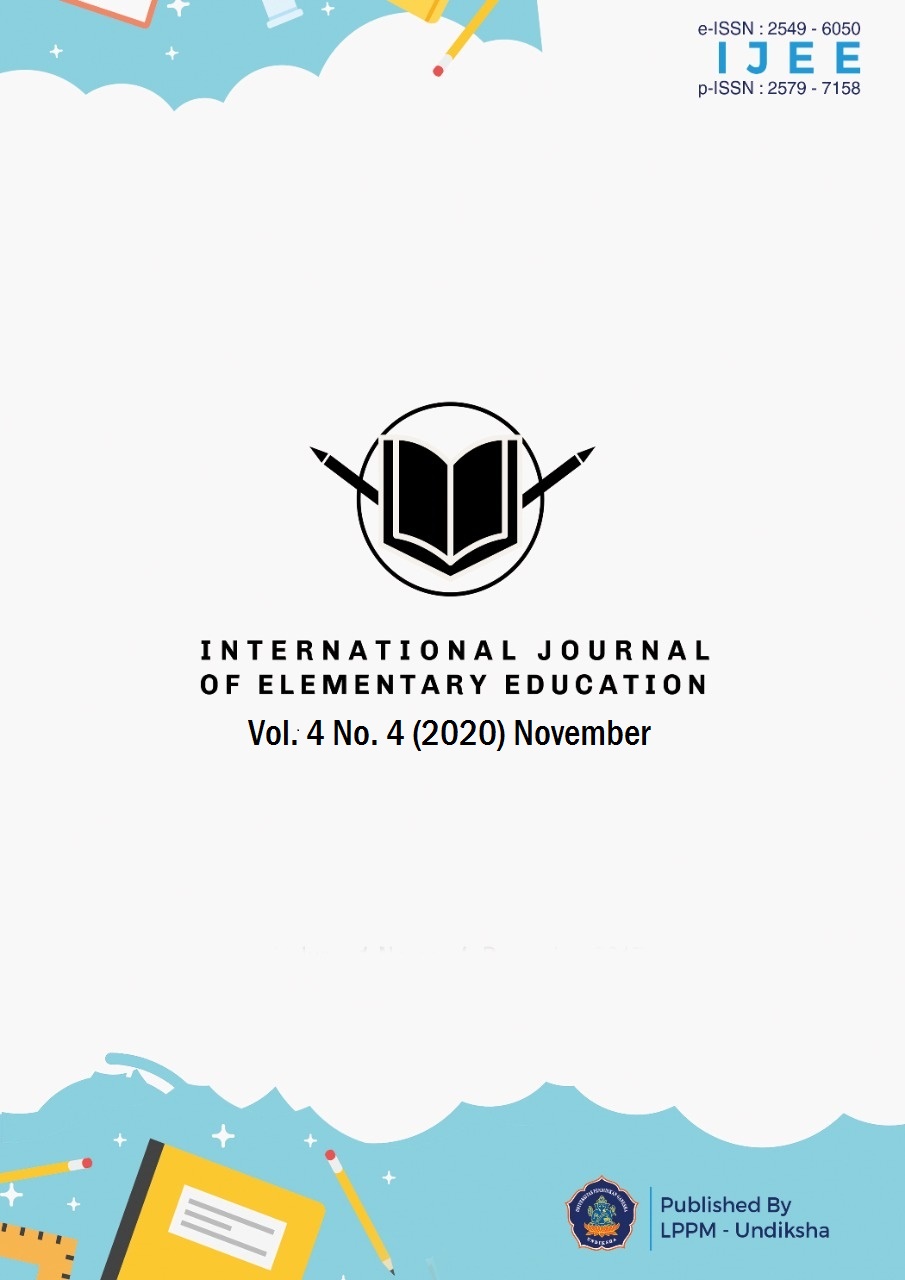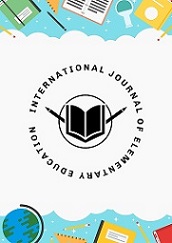The Use of Video in Improving Students’ Attention in Learning Process of Kindergarten Students
DOI:
https://doi.org/10.23887/ijee.v4i4.28430Keywords:
media, characteristics, attention, learning processAbstract
One problem that often arises in the learning process is that students' attention is quite minimal during the learning process. This thing cannot be separated from the characteristic of kindergarten students, that is they have a short attention span. This, of course, can make the learning process ineffective. It is important to use the teacher's creativity to make the students pay attention during the learning process. Teachers can take advantage of the current industrial revolution 4.0 by using the technologies around them, such as the use of videos to attract students' attention so that the learning process becomes effective. This paper aims to see the effectiveness of the use of video to attract students' attention. Education is a learning process that occurs throughout life. Student’s attention is needed for the material taught by the teacher during the learning process. It will make the students able to understand the material being taught. The use of video is very effective in attracting the students’ attention. It is necessary for the teacher to know the characteristics of the students and to follow the development of technology to be able to provide the teaching media that suits the students' needs.
References
Akkoyun, Y., & Erkan, T. E. (2014). Lifelong Learning Case Study from Turkish Public Sector: Business Process Management in Social Security Operations. Procedia - Social and Behavioral Sciences, 116(Lll), 1154–1159. https://doi.org/10.1016/j.sbspro.2014.01.361
Alalwan, N., Cheng, L., Al-Samarraie, H., Yousef, R., Ibrahim Alzahrani, A., & Sarsam, S. M. (2020). Challenges and Prospects of Virtual Reality and Augmented Reality Utilization among Primary School Teachers: A Developing Country Perspective. Studies in Educational Evaluation, 66(March), 100876. https://doi.org/10.1016/j.stueduc.2020.100876
Anam, K., Purwadi, P., & Chandra, A. (2017). Upaya Meningkatkan Kosentrasi Belajar Anak Melalui Bermain Papan Titian Di Tk Indria Desa Kutosari Kecamatan Gringsing Kabupaten Batang. Paudia, 6(2). https://doi.org/https://doi.org/10.26877/paudia.v6i2.2106
Ansori, N., & Yuliansyah, H. (2018). Perancangan Media Pembelajaran Manfaat Enam Jenis Sayuran Untuk Siswa PAUD Di Kota Bandung. Sketsa, 5(1), 35–44. https://ejournal.bsi.ac.id/ejurnal/index.php/sketsa/article/view/4249/2622
Ariyanti, T. (2016). Pentingnya Pendidikan Anak Usia Dini Bagi Tumbuh Kembang Anak The Importance Of Childhood Education For Child Development. Dinamika Jurnal Ilmiah Pendidikan Dasar, 8(1). https://doi.org/http://dx.doi.org/10.30595/dinamika.v8i1.943
Beheshti, M., Taspolat, A., Kaya, O. S., & Sapanca, H. F. (2018). Charateristics of Educational Videos. World Journal on Educational Technology, 10(1), 61–69. https://files.eric.ed.gov/fulltext/EJ1170366.pdf
Can, A. A., & Yüksel, U. (2012). Assessment of music education courses of public education center in the direction of the trainees opinions in the process of lifelong learning. Procedia - Social and Behavioral Sciences, 31(2011), 704–713. https://doi.org/10.1016/j.sbspro.2011.12.128
Chrystanti, Y. C., & Sukadi, S. (2015). Media Pembelajaran Pengenalan Huruf Dan Angka Di Taman Kanak-Kanak Tunas Putra Sumberharjo. Journal Speed – Sentra Penelitian Engineering Dan Edukasi, 7(3), 23–29. http://ijns.org/journal/index.php/speed/article/view/1203
Dhamayanti, Y., & Suparno, S. (2015). Keefektifan PAUD inklusi pada kesiapan anak memasuki sekolah dasar. Jurnal Pendidikan Dan Pemberdayaan Masyarakat, 2(1), 107. https://doi.org/10.21831/jppm.v2i1.4847
Drude, K. P., Maheu, M., & Hilty, D. M. (2019). Continuing Professional Development: Reflections on a Lifelong Learning Process. Psychiatric Clinics of North America, 42(3), 447–461. https://doi.org/10.1016/j.psc.2019.05.002
Fadhilah, F. (2015). Media Pembelajaran yang Cocok bagi Anak-anak Usia Dini Taman Kanak-kanak. Serambi Tarbawi, 4(2), 21–40. https://doi.org/https://doi.org/10.32672/tarbawi.v3i2.1246
Fauziddin, F. (2016). Peningkatan Kemampuan Matematika Anak Usia Dini Melalui Permainan Jam Pintar Di Taman Kanak - Kanak Pembina Kec. Bangkinang Kota. Jurnal Paud Tambusai, 2(1), 55–62. file:///C:/Users/7/Downloads/55-106-1-SM.pdf
Fitria, A. (2018). Penggunaan Media Audio Visual Dalam Pembelajaran Anak Usia Dini. Cakrawala Dini: Jurnal Pendidikan Anak Usia Dini, 5(2), 57–62. https://doi.org/10.17509/cd.v5i2.10498
FitzGibbon, L., Moll, H., Carboni, J., Lee, R., & Dehghani, M. (2019). Counterfactual curiosity in preschool children. Journal of Experimental Child Psychology, 183, 146–157. https://doi.org/10.1016/j.jecp.2018.11.022
Hartati, S., & Novrika, G. V. (2018). Using educational video to promoting listening skill children of 5-6 years old. Early Childhood Education Journal of Indonesia, 1(1), 27–35. https://journal.unnes.ac.id/sju/index.php/eceji/article/view/23987/11097
Heriyanto, H. (2014). Studi Pembelajaran Rumah Qurani Dalam Meningkatkan Kemampuan Berbahasa Anak Usia Dini Di Ra Assakinah Sejahtera Kab. Bandung Barat. Empowerment, 4(2). https://doi.org/https://doi.org/10.22460/empowerment.v3i2p198-215.585
Ismawati, D., & Prasetyo, I. (2021). Efektivitas Pembelajaran Menggunakan Video Zoom Cloud Meeting pada Anak Usia Dini Era Pandemi Covid-19. Jurnal Obsesi : Jurnal Pendidikan Anak Usia Dini, 5(1), 665–675. https://doi.org/10.31004/obsesi.v5i1.671
Kriyantoro, R. (2007). Teknik Praktis Riset Komunikasi. Kencana.
Moleong, L. (2010). Metodologi Penelitian Kualitatif. PT Remaja Rosdayakarya.
Muttaqien, F. (2017). Penggunaan Media Audio-Visual dan Aktivitas Belajar dalam Meningkatkan Hasil Belajar Vocabulary Siswa pada Mata Pelajaran Bahasa Inggris Kelas X. Jurnal Wawasan Ilmiah, 8(1), 25–41. https://jurnal.amikgarut.ac.id/index.php/jwi/article/download/27/29
Nurdiani, Y. (2013). Penerapan Prinsip Bermain Sambil Belajar Dalam Mengembangkan Multiple Inteligencia Pada Pendidikan Anak Usia Dini (Study Kasus Di PAUD Daarul Piqri Kelurahan Leuwigajah Cimahi Selatan). Empowerment, 2(2). https://doi.org/https://doi.org/10.22460/empowerment.v2i2p85-93.601
Panjaitan, R. (2017). Metodologi Penelitian. Jusuf Aryani Learning.
Peterson, E. G. (2020). Supporting curiosity in schools and classrooms. Current Opinion in Behavioral Sciences, 35, 7–13. https://doi.org/10.1016/j.cobeha.2020.05.006
Rohmawati, A. (2015). Efektivitas Pembelajaran. Jurnal Pendidikan Usia Dini, 9(1), 15–32. https://doi.org/https://doi.org/10.21009/JPUD.091
Seufert, S., Guggemos, J., & Sailer, M. (2021). Technology-related knowledge, skills, and attitudes of pre- and in-service teachers: The current situation and emerging trends. Computers in Human Behavior, 115, 106552. https://doi.org/10.1016/j.chb.2020.106552
Subarkah, M. A. (2019). Pengaruh Gadget Terhadap Perkembangan Anak. Rausyan Fikr : Jurnal Pemikiran Dan Pencerahan, 15(1), 125–139. https://doi.org/10.31000/rf.v15i1.1374
Wartini, A., Hadi al-asy’ari, M. K., & Multahada, A. (2017). Menggagas Model Pembelajaran Discovery-Inquiry pada Pendidikan Anak Usia Dini. Intizar, 23(1), 151–164. https://doi.org/10.19109/intizar.v23i1.1614
Yuliani, D., Antara, P. A., & Magta, M. (2017). Pengaruh Video Pembelajaran Terhadap Kemampuan Berhitung Permulaan Anak Kelompok B Di Taman Kanak-Kanak. Pendidikan Anak Usia Dini Universitas Pendidikan Ganesha, 5(1), 96–105. https://doi.org/http://dx.doi.org/10.23887/paud.v5i1.11309
Downloads
Published
How to Cite
Issue
Section
License
Authors who publish with the International Journal of Elementary Education agree to the following terms:
- Authors retain copyright and grant the journal the right of first publication with the work simultaneously licensed under a Creative Commons Attribution License (CC BY-SA 4.0) that allows others to share the work with an acknowledgment of the work's authorship and initial publication in this journal.
- Authors are able to enter into separate, additional contractual arrangements for the non-exclusive distribution of the journal's published version of the work (e.g., post it to an institutional repository or publish it in a book), with an acknowledgment of its initial publication in this journal.
- Authors are permitted and encouraged to post their work online (e.g., in institutional repositories or on their website) prior to and during the submission process, as it can lead to productive exchanges, as well as earlier and greater citation of published work. (See The Effect of Open Access)










